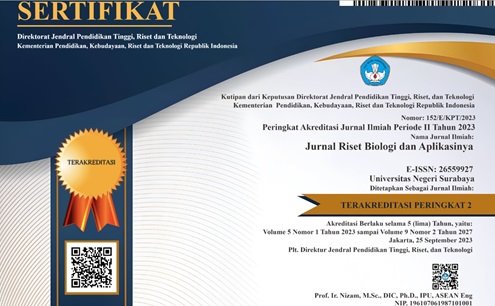Komunitas Bivalvia yang Berasosiasi dengan Kerang Lentera (Brachiopoda: Lingulata) di Zona Intertidal Selat Madura
DOI:
https://doi.org/10.26740/jrba.v2n1.p36-41Keywords:
Bivalvia, Brachiopoda, kerang lentera, Koreamya sp.Abstract
Kerang lentera merupakan salah satu makrobentos penyusun ekosistem intertidal berlumpur. Penelitian ini bertujuan untuk mendeskripsikan komunitas bivalvia yang yang berasosiasi dengan kerang lentera di zona intertidal Selat Madura. Sampling dengan menggunakan metode simple random sampling pada lima lokasi yang telah ditentukan, yakni di Kabupaten Probolinggo, Kabupaten Situbondo, Kabupaten Bangkalan, Kecamatan Kwanyar-Bangkalan, dan Kabupaten Pamekasan. Pengambilan sampel dilakukan dengan menggali substrat pada area plot sedalam 5-10 cm. Hasil penelitian menunjukkan bahwa dijumpai 15 spesies anggota kelas Bivalvia yang memiliki ko-eksistensi dan berasosiasi dengan kerang lentera (Brachiopoda) yang berasal dari famili Arcidae, Veneridae, Solenidae, Cardiidae, Lucinidae, Lasaeidae, Laternulidae, Mactridae, dan Tellinidae. Koreamya sp. merupakan spesies yang berasosiasi komensalisme dengan kerang lentera (Brachiopoda: Lingulata).
References
Bitner, M. A., Dulai, A., Kocsis, L., & Müller, P. M. (2012). Lingula dregeri (Brachiopoda) from the Middle Miocene of Hungary. Annales Societatis Geologorum Poloniae, 82, 3943. Diakses dari https://yadda.icm.edu.pl/baztech/element/bwmeta1.element.baztech-4f70b2f8-82c2-47b1-a1c7-f215861fb1cc
Bloomfield, A. L., dan Gillanders, B. M. (2005). Fish and Invertebrate Assemblages in Seagrass, Mangrove, Saltmarsh, and Nonvegetated Habitats. Estuaries, 28(1), 6377. Diakses dari http://www.issg.org/pdf/publications/GISP/Resources/SEAsia-1.pdf
Carlson, S. J. (2016). The Evolution of Brachiopoda. Annual Review of Earth and Planetary Sciences, (44), 409438. https://doi.org/10.1146/annurev-earth-060115-012348
Dharma, B. (2005). Recent and Fossil Indonesian Shells. Conchbooks, Hackenheim.
Goto, R., Ishikawa, H., Hamamura, Y., Sato, S., & Kato, M. (2014). Evolution of Symbiosis with Lingula (Brachiopoda) in the Bivalve Superfamily Galeommatoidea (Heterodonta), with Description of a New Species of Koreamya. Journal of Molluscan Studies, 80(2), 148160. https://doi.org/10.1093/mollus/eyu009
Handayani, T. (2017). Potensi Makroalga di Paparan Terumbu Karang Perairan Teluk Lampung. Oseanologi Dan Limnologi Di Indonesia, 2(1), 5567. Diakses dari http://www.jurnal-oldi.or.id/index.php/oldi/article/view/15
Koneva, S. P., dan Ushatinskaya, G. T. (2008). New Upper Cambrian Lingulata (Brachiopoda) from the Agyrek Mountains (Northeastern Central Kazakhstan). Paleontological Journal, 2(42), 139148.
https://doi.org/10.1134/S0031030108020044
Lindawaty, Dewiyanti, I., & Karina, S. (2016). Distribusi dan Kepadatan Kerang Darah (Anadara sp.) berdasarkan Tekstur Substrat di Perairan Ulee Lheue Banda Aceh. Jurnal Ilmiah Mahasiswa Kelautan Dan Perikanan Unsyiah, 1(1), 114123.
Luetzen, J. (2009). Koreamya arcuata (A. Adams, 1856) gen. nov. (Galeommatoidea: montacutidae), a Commensal Bivalve Associated with the Inarticulate Brachiopod Lingula anatina. Journal of Conchology, 39(6), 669679.
Macfarlan, D. A. B., Bradshaw, M. A., Campbell, H. J., Cooper, R. A., Lee, D. E., Mackinnon, D. I., Robinson, J. H. (2009). Phylum Brachiopoda Lamp Shells. New Zealand Inventory of Biodiversity, 255267. Diakses dari https://www.researchgate.net/publication/269519543_Phylum_Brachiopoda_lamp_shells
Mitra, S., dan Pattanayak, J. G. (2013). Studies on Lingula anatina (Brachiopoda: Inarticulata) in Subarnarekha Estuary, Odisha with special reference to habitat and population. Rec. Zool. Surv. India, 113(Part 3), 4953. Diakses dari http://recordsofzsi.com/index.php/zsoi/article/view/121795
Negelkerken, I., Dorenbosch, M., Verberk, W. C. E. P., Cocheret de la Moriniere, E., & van der Verlde, G. (2000). Importance of Shallow-water Biotopes of a Caribbean Bay for Juvenile Coral Reef Fishes: Patterns in Biotope Association, Community Structure and Spatial Distribution. Marine Ecology Progress Series, 202, 175192. Diakses dari https://www.int-res.com/abstracts/meps/v202/p175-192/
Nybakken, M. D., dan Bertness, J. W. (2005). Marine Biology: An Ecological Approach (6th ed.). San Fransisco: Pearson Education, Inc. Benjamin Cummmings.
Pechenik, J. A. (2010). Biology of the invertebrates (6th ed.). McGraw-Hill Higher Education.
Riniatsih, I., dan Kushartono, E. W. (2009). Substrat Dasar dan Parameter Oseanografi sebagai Penentu Keberadaan Gastropoda dan Bivalvia di Pantai Sluke Kabupaten Rembang. Ilmu Kelautan: Indonesian Journal of Marine Sciences, 14(1), 5059. Diakses dari https://ejournal.undip.ac.id/index.php/ijms/article/view/221
Samanta, S., Choudhury, A., dan Chakraborty, S. K. (2014). Morpho-anatomical study of Lingula anatina Lamarck, 1801 from West Bengal-Odisha coast, India. Journal of the Marine Biological Association of India, 56(2), 2633. https://doi.org/10.6024/jmbai.2014.56.2.01775-04
Samanta, S., Choudhury, A., dan Chakraborty, S. K. (2015). Eco-biology of a Precambrian intertidal benthic brachiopod, Lingula anatina from the confluence of Subarnarekha estuary with Bay of Bengal, India. Journal of the Marine Biological Association of India, 57(1), 4146. https://doi.org/10.6024/jmbai.2015.57.1.1836-06
Sato, S., Owada, M., Haga, T., Hong, J. S., Lützen, J., & Yamashita, H. (2011). Genus-specific commensalism of the galeommatoid bivalve Koreamya arcuata (A. Adams, 1856) associated with lingulid brachiopods. Molluscan Research, 31(2), 95105. Diakses dari https://static-curis.ku.dk/portal/files/164534570/Sato_2011_Genus_specific.pdf
Savazzi, E. (2001). A Review of Symbiosis in the Bivalvia, with Special Attention to Macrosymbiosis. Paleontological Research, 5(1), 5573. Diakses dari https://www.jstage.jst.go.jp/article/prpsj1997/5/1/5_1_55/_article/-char/ja/
Skovsted, C., Pan, B., Topper, T. P., Betts, M. J., Li, G., & Brock, G. A. (2016). The Operculum and Mode of Life of The Lower Cambrian Hyolith Cupitheca from South Australia and North China. Palaeogeography, Palaeoclimatology, Palaeoecology 443: 123-130. https://doi.org/10.1016/j.palaeo.2015.11.042
Subiyanto, Hartoko, A., & Umah, K. (2013). Stuktur Sedimen dan Sebaran Kerang Pisau (Solen lamarckii) Di Pantai Kejawanan Cirebon Jawa Barat. Journal of management of aquatic resources, 2(3), 6573. Diakses dari http://ejournal-s1.undip.ac.id/index.php/maquares
Taqwa, R. N., Muskananfola, M. R., & Ruswahyuni. (2014). Studi Hubungan Substrat Dasar dan Hubungan Bahan Organik dalam Sedimen dengan Kelimpahan Hewan Makrobenthos di Muara Sungai Sayung Kabupaten Demak. Management of Aquatic Resources, 3(1), 125133. Diakses dari https://ejournal3.undip.ac.id/index.php/maquares/article/view/4429
Zhang, X. G., Hou, X. G., & Emig, C. C. (2003). Evidence of lophophore diversity in Early Cambrian Brachiopoda. Proceedings of the Royal Society B: Biological Sciences, 270(SUPPL. 1), 6568. https://doi.org/10.1098/rsbl.2003.0013
Downloads
Published
How to Cite
Issue
Section
 Abstract views: 3508
,
Abstract views: 3508
, PDF Downloads: 7358
PDF Downloads: 7358












